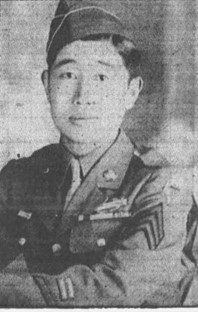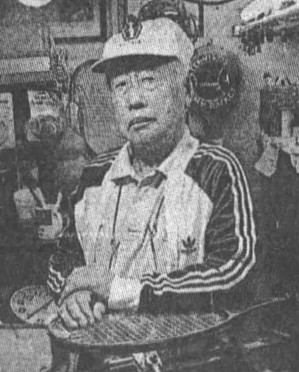
Shuichi Hirakawa
Sergeant
442nd Regimental Combat Team
2nd Battalion, G Company
Shuichi Hirakawa was born on March 1, 1916, in San Francisco, California. He was the eldest child of Kazutoshi and Iso (Ogino) Hirakawa, who emigrated from Yamanashi Prefecture, Japan, in 1903 and 1915, respectively. He had two younger sisters, Toshi and Kazuye.
Kazutoshi was single and working as the servant in the 1282 Sacramento Street home of Mark and Bettie Emanuel in 1910. By 1915, he had married Iso Ogino, who arrived on the S.S. Manchuria on May 3, 1915, as his wife, enroute to Vacaville, Solano County, about 60 miles northwest of San Francisco. In 1920, the family of five was living in Vacaville, where Kazutoshi was a “cropper” on a fruit ranch. Living with the family was his father’s partner, Hisashi Fushimi, who worked in a fruit orchard. Fushimi had arrived in California in 1907 from Yamanashi Prefecture.
In late 1920s, Suichi’s parents returned to Japan with their children. On October 24, 1929, Kazutoshi left his family in Japan and arrived back in California on the Asama Maru, enroute to spend a maximum of six months with his brother, Ginji Furuya, P.O. Box 727 in Vacaville.
On February 15, 1934, Shuichi left from Yokohama on the Chichibu Maru, arriving at San Francisco on February 28. He had been living with his family at 290 Kamizone-mura in Yamanashi Prefecture. His father sent him to California to avoid being conscripted into the Imperial Army during the occupation of Manchuria. He was returning to the US permanently and enroute to the family friend, Hisashi Fushimi of 608 Hemlock Street, San Francisco.
Shuichi was soon living with Mrs. Marie Hicks Davidson, well-known and long-time music critic and society editor for several newspapers in San Francisco. She had been widowed years earlier and her only son had died. Mrs. Davidson gave Shuichi the nickname “Moto.” He worked as her “houseboy” while he attended George Washington High School.
Shuichi signed his draft registration card on October 16, 1940, Local Board No. 97, at 1819 Polk Street, San Francisco. He was 5’3-1/2” tall and weighed 120 pounds. At the time, he was living at 2109 Broadway where he was employed by Mrs. Marie Hicks Davidson of the same address. He listed his point of contact as his friends Mr. and Mrs. Hisashi Fushimi of 1676 Geary Street.
On November 7, 1941, Shuichi enlisted in the U.S. Army in San Francisco. At the time he had completed one year of college and listed his occupation as “actor.” He was sent to Camp Roberts, where he was a month later when the attack on Pearl Harbor occurred. He later said that the attack had not surprised him. He was sent to Camp Roberts, near Paso Robles, California, for basic training.
When the 442nd Regimental Combat Team was organized in February 1943, Shuichi was transferred to Camp Shelby, Mississippi, where he was assigned to 2nd Battalion, G Company.
After a year of training, including combat and specialty training and field maneuvers, Sergeant Hirakawa was granted a leave. He went to visit his family friends, Hisashi and Haruye Fushimi where they were incarcerated at the Central Utah WRA internment camp, also known as Topaz. He was with the 442nd when they left Camp Shelby on April 22, 1944, for Camp Patrick Henry, Virginia. The Combat Team sailed from nearby Hampton Roads on May 2 in a large convoy of over 100 ships and arrived in the Mediterranean Theater of War in late May.
After entering the Mediterranean, the ships carrying the bulk of the 2nd Battalion dropped out of the convoy and steamed into Oran, on the coast of North Africa, to discharge cargo. The other ships arrived at Naples, Italy, on May 28. It is not known in which of these groups Hirakawa was traveling.
The battalion spent a week at a staging area in Bagnoli, near Naples, before leaving on LSTs for Anzio on June 6, where they marched five miles to a bivouac area. From Anzio the 442nd went to a large bivouac area at Civitavecchia, north of Rome, where they went through additional training and final preparations for going to the front lines. The ships that had stopped in Oran arrived on June 17, going through the same processing as the other units.
Hirakawa first entered combat on June 26, when the Combat Team engaged German forces at the village of Belvedere near Suvereto, Tuscany. Second and Third Battalions were the first to engage the enemy in a fierce firefight. As they pushed the enemy north, the 442nd encountered sporadic resistance, including the battle at Hill 140, dubbed “Little Cassino.”
They rested in Vada on the Etruscan Coast from July 25 to August 15, when the 442nd moved to patrol the Arno. Crossing the Arno on August 31 was relatively uneventful, as they were guarding the north side of the river in order for bridges to be built. On September 11, the 442nd was detached from the Fifth Army and then attached to the 36th Infantry Division of the Seventh Army. The Regiment was pulled from the front lines and sent to Naples. After leaving Naples, the 442nd landed in Marseilles on September 30, and for the next two weeks they traveled 500 miles through the Rhone Valley, by truck and by rail boxcar, until October 13, when they reached the battle front in northeastern France to fight in the Rhineland-Vosges Campaign.
Their first objective was to liberate the important road junction of Bruyères in the Vosges Mountains. The intense battles to liberate Bruyères and neighboring Biffontaine lasted from October 16-24. The combat team was then put into reserve in Belmont for a brief rest. After two days, on the afternoon of October 26, they were ordered to the front lines again to aid in the rescue of the “Lost Battalion” – the 1st Battalion of the 141st (Texas) Infantry Regiment. This battalion had gotten ahead of the lines and was surrounded on three sides by the enemy. Attempts by the 141st and other units to free it had been unsuccessful, so the 442nd was called in.
According to an interview of Hirakawa in theSan Francisco Examiner on December 1, 1991, he was badly wounded during the heavy fighting in the Vosges in October 1944. He then spent the next year and a half in a hospital before returning home. During this time, he was discharged from the Army on June 30, 1945.
For his military service, Sergeant Shuichi Hirakawa was awarded the Bronze Star Medal, Purple Heart Medal, Distinguished Unit Badge, Good Conduct Medal, American Defense Campaign, European-African-Middle Eastern Campaign Medal with two bronze stars, World War II Victory Medal, and Combat Infantryman Badge. He was posthumously awarded the Congressional Gold Medal on October 5, 2010, along with the other veterans of the 100th/442nd Regimental Combat Team. This is the highest Congressional Civilian Medal.
During the time that Shuichi was fighting in Italy and France, Mrs. Davidson had written to him weekly. After visiting with her upon his return to San Francisco, he went on to Japan, were he worked for the U.S. Army Corps of Engineers. He married Yae Fuji, a native of Japan who was born in 1918. They raised a family of three daughters and lived in Japan until 1961, when Shuichi, Yae, and their youngest daughter moved to California. Shuichi had heard that his dear friend and mentor, Mrs. Davidson, had retired due to ill health and that she was ailing. Upon arriving at the San Francisco Airport, he called Mrs. Davidson and told her he was there with his wife and youngest daughter and he wished to repay some of the kindness she had shown him over the years. The Hirakawas lived with Mrs. Davidson in her Victorian mansion at 2109 Broadway until she died in 1963.

He worked for the military at the nearby Presidio. In the 1970s, Shuichi was active in local tennis tournaments and at the age of 75 was still a ranked tennis player. After retirement in 1981, he operated a small gift shop in the Marina District where he sold imported goods and restrung tennis rackets.
Hirakawa in his gift shop in 1991, with a 442nd patch on his cap
Shuichi Hirakawa died on February 6, 1999, at the Veterans Administration Hospital in San Francisco. His funeral was held on February 17 at the Buddhist Church of San Francisco, 1881 Pine Street. He is buried at the Japanese Cemetery in Colma, San Mateo County, California. He was survived by his wife and children. On December 15, 2006, Yae Hirakawa died and was buried with her husband.
Researched and written by the Sons & Daughters of the 442nd Regimental Combat Team in 2023.
